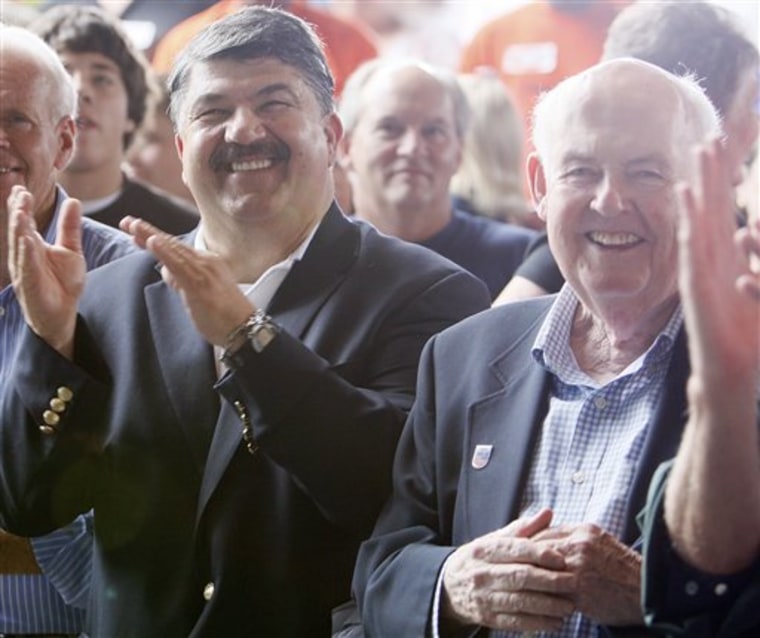John Sweeney spent the past 14 years building the AFL-CIO into a political powerhouse for worker's rights and other progressive Democratic causes.
Yet over the same time, the ranks of union members continued to shrink, diminishing organized labor's clout in the workplace. Frustration with Sweeney's tenure and the dip in membership led seven unions to split from the AFL-CIO four years ago to form the rival Change to Win federation.
As Sweeney, 75, prepares to step down next week as AFL-CIO president, his successor and longtime deputy — Richard Trumka — wants to aggressively recruit younger workers and boost membership as a means of expanding labor's political influence.
Trumka, 60, officially takes the helm of the AFL-CIO at its quadrennial convention, which opens Sunday in Pittsburgh. On Tuesday, President Barack Obama addresses the nation's largest labor federation, which represents about 11 million workers in 56 unions.
By many accounts, Sweeney transformed a moribund labor movement in the mid-1990s by firmly aligning the AFL-CIO with the Democratic left. The son of working class Irish immigrants from the Bronx repositioned the AFL-CIO as a champion of social Democratic causes by forging alliances with civil rights leaders, women's groups, environmental and anti-poverty groups.
Besides giving the federation more political heft, he mobilized rank-and-file union members to boost political activism, beef up voter registration drives and expand get-out-the-vote efforts. Sweeney also started Working America, an AFL-CIO affiliate for people who don't have a union at work, that now boasts 3 million members.
"He turned to these new models of organizing the base as a way to gain political power," said Dorothy Sue Cobble, professor of history and labor studies at Rutgers University in New Brunswick, N.J.
Making political action a year-round affair, rather than just focusing on elections, allowed the AFL-CIO to mobilize quickly this summer to help Obama push his health care overhaul. Last month, 24,000-plus union members showed up at more than 400 town hall meetings and rallies in all 50 states to counter those who oppose Obama's ideas for changing health care.
But Sweeney could not seem to find the answer to steep membership declines. Union membership now stands at about 12.4 percent, down from a high of 35 percent in the 1950s. The drop has been steeper in the private sector, which has shrunk to 7.6 percent from about 17 percent in the 1980s.
At the AFL-CIO's 2004 convention in Chicago, several of the federation's largest unions resigned. Led by Service Employees International Union president Andy Stern, the leaders complained there was not enough emphasis on organizing and too much emphasis on politics.
"There's no question about it, the disaffiliation was very hard," Sweeney said in an interview. "We really can't afford to be split."
While the AFL-CIO took a major financial hit from lost dues, union leaders say the split was felt more at the top than at the lower ranks, where most local unions continued to affiliate with the old federation.
The impact at the new Change to Win federation was less dramatic than expected. SEIU and the Teamsters have seen modest growth, but other unions have not done as well. And the newer federation has continued to spend heavily on political efforts too.
"There is a great temptation to run up and down the street yelling 'I told you so'" to those who left, said Sweeney supporter Gerald McEntee, president of the American Federation of State, County and Municipal Employees.
Now that labor has a Democrat in the White House and a solid Democratic majority in Congress, several of the departed unions are considering a return to the AFL-CIO. The two federations have worked together to help Obama enact his economic stimulus package and seek improvements to the health care system.
The AFL-CIO is expected to be even more aggressive in pursuing its political agenda under Trumka's more charismatic brand of leadership. Trumka made waves last month when he said Democratic lawmakers would pay a political price if they don't include a government-run option in any health care overhaul.
Trumka, who officially takes the helm of the AFL-CIO on Wednesday, also has made clear that unions need to speak to the needs of young workers to increase membership. He plans to boost outreach on college campuses and appeals to professional and technical workers.
"Ultimately, it won't matter how many unions are in the AFL-CIO if we fail to capture the imagination of millennials," Trumka said in a recent speech.
Labor leaders are also counting on Congress to pass a measure this year that would make it easier for workers to organize unions. Obama has assured union leaders that he will work to pass the Employee Free Choice Act once health care legislation is done.
Business groups adamantly oppose the union organizing bill, and Democratic lawmakers are trying to reach a compromise that can muster enough votes to overcome a filibuster in the Senate.
